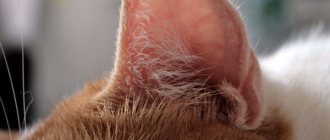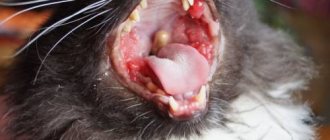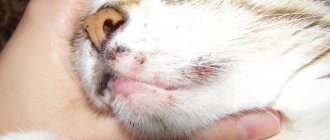How can an animal get burned?
In addition to tragic situations, such as a fire, a cat can suffer from a burn for simple, trivial reasons. A pet that gets too playful can lose control and get scalded on a heating device; a cat can also easily knock over a pot of soup, a frying pan with oil, etc. Young cats need to sharpen their teeth, sometimes during birth they come across live wires under their paws, as a result - electric shock and electrical burn. Cats are curious creatures. Therefore, try to hide possible sources of burns from them.
Of course, loving owners take all measures to prevent accidents, but, unfortunately, we are not able to foresee all the dangers. What to do if your cat gets burned?
In this article we will not talk about the treatment of burns, but about first aid, or pre-medical aid. Because in all cases of burns, except for the mildest ones, the cat needs to be examined by a doctor who can provide the necessary assistance and recommend subsequent treatment.
Causes of burns in cats
The curiosity of cats has long been the talk of the town and, unfortunately, can cause problems not only for the owner, but also for the animal itself. Dexterity and mobility allow your pet to climb even into the most inaccessible places located at any height. In everyday life, gas and electric stoves, heaters, and other household heating devices for various purposes can pose a danger to a cat. In addition, trying to find out the nature of the contents or attracted by an unusual smell, a cat may knock over a pan of hot food, a kettle of boiling water, or a container with a dangerous chemical.
When purchasing a kitten, owners are required to take into account the behavior of the pet and try to minimize the risk of burns, and if injury cannot be avoided, be able to determine the severity of the damage and immediately provide first aid.
Degrees of burns in cats
First degree. The cat had a small area of his body burned. The burn site is swollen, red, and painful. Your pet may develop a fever.
The second degree is similar in symptoms to the first, only more pronounced. Plus, watery blisters may appear on the affected skin, which will then burst and crusts will appear in their place. If a cat's burn is too large, the animal will experience weakness and refuse to eat. Naturally, the animal will be in pain and its body temperature will increase.
The third degree is wounds covered with charred crusts. After a few hours, necrosis begins in the burn area. In addition to severe pain, the animal will receive internal intoxication. An increase in temperature and general poor health is inevitable.
Why are burns dangerous for a cat?
Healthy skin is a barrier that protects the animal’s body from environmental influences. The burned area loses its protective function - the risk of infection entering through the burn increases. In addition, this:
- pain;
- discomfort;
- disability.
If the burn covers a large area of the body - more than 15%, then there is no good prognosis for recovery; you will have to fight for your pet. If a cat's burn exceeds 50% of the total body area, then the animal will most likely die.
In addition to the skin, the pet can burn the oral cavity (electric shock when biting through wiring) and the upper respiratory tract (inhalation of acid steam, hot smoke). These types of burns not only bring significant discomfort to pets, they are actually life-threatening. For example, an animal may develop swelling of the respiratory tract due to a burn. As a result, the pet will no longer receive enough oxygen and will die as a result.
Thermal burns
Of course, not all of our pets are raised correctly, so unpleasant situations can often arise due to their excessive curiosity. Such burns in a cat occur when exposed to hot steam, boiling water, hot oil or direct open flame. A particularly dangerous place is the kitchen, because this is where cats most often get burned, trying, no matter what, to steal the treat they like.
Some cats are practically fearless, and no matter how much they are chased, they are still drawn either to a pot of boiling water or to the fire. The result is a serious burn on the cat due to the fact that it singed its fur or knocked over a container of hot liquid on itself.
What to do?
How to treat a thermal burn in a cat? Place the burned area of the body under running cold water and hold for 10-15 minutes. We treat the burn with a solution of potassium permanganate, then apply a compress (a cloth soaked in cold water), which we change as it dries until examined by a doctor.
Types and degrees of burns
The reasons for getting burns can be different. Careless behavior of the owners and active curiosity of the cat can lead to injury. Your pet may suffer the following burns:
- thermal,
- chemical,
- sunny.
Thermal burns are the most common option. You can accidentally spill a hot drink or food on a cat that accidentally gets under your feet. She may show excessive curiosity, “touch” the iron, tiles, jump onto a hot surface, etc.
Chemical burns are the result of contact with liquids containing acids or alkalis. The likelihood of such injury occurs if the storage rules for these dangerous drugs are not followed.
Sunburn can occur from prolonged exposure to direct sunlight. They affect mainly hairless breeds. These pets need protection from intense exposure to ultraviolet radiation.
All burns according to the scale and depth of damage to the skin are classified into 3 degrees:
- I degree is characterized by minor damage to the upper layers of the skin, redness and slight swelling are observed;
- Stage II affects the middle layers of the dermis, causing blisters to appear, which will gradually break through;
- Grade III is the most severe, causing complete damage to the structure of the integument, accompanied by tissue necrosis.
Electrical shock burns
Such burns most often occur when a cat chews an electrical wire while playing. The consequences of electric shock in a cat are severe burns, swelling of the larynx and lungs. When providing first aid, it is necessary to turn off the electricity and remove the cat from the source of electric shock. If you do not know how to turn off the electricity, or do not have the opportunity to do this, then drag the cat away with a wooden stick or a broom (not metal).
If possible, immediately call an emergency veterinarian and follow their recommendations. If this is not possible, then treat the cat’s burns with a weak solution of furatsilin or potassium permanganate. Then, wrap the victim in something warm and immediately take her to the doctor. Only he can prevent or relieve swelling and treat burns in a cat.
Types and causes of burns
Among the injuries, veterinarians distinguish the following:
- External. These include burning of the skin on various parts of the body.
- Internal. The brain and visceral organs are affected.
Damages also vary depending on the cause of their occurrence. Types and provoking factors:
Household chemicals are potentially dangerous for pets.
- Chemical burn. It occurs due to exposure of aggressive chemicals to the skin or body of a cat - alkaline or acidic solutions, organic substances (phenols), bleach. A cat receives such damage if it accidentally spills or drinks household chemicals on itself.
- Thermal burn in a cat. It develops under the influence of high temperatures on the skin if the cat steps on the surface of an iron or heating device, jumps on a hot stove, or stays near an open fire, especially while wearing flammable clothing. Sometimes the owner accidentally pours boiling water on the pet if it gets underfoot in the kitchen.
- Electric. It occurs when a cat accidentally steps on a wire with damaged insulation or has a habit of playing and biting wires.
- Solar. It affects hairless cats if the animal has been in the sun for a long time without protective clothing.
- Burn of internal organs. The structures of the respiratory or digestive system are most often affected. Occur due to inhalation of combustion products, toxic gases or ingestion of chemicals. The tongue, larynx, esophagus, and stomach are affected.
- Eye damage. Occurs due to chemicals entering the eye structures. These are various household aerosols, insect poison, gas.
Electrical shock burns
Such burns most often occur when a cat chews an electrical wire while playing. The consequences of electric shock in a cat are severe burns, swelling of the larynx and lungs. When providing first aid, it is necessary to turn off the electricity and remove the cat from the source of electric shock. If you do not know how to turn off the electricity, or do not have the opportunity to do this, then drag the cat away with a wooden stick or a broom (not metal).
If possible, immediately call an emergency veterinarian and follow their recommendations. If this is not possible, then treat the cat’s burns with a weak solution of furatsilin or potassium permanganate. Then, wrap the victim in something warm and immediately take her to the doctor. Only he can prevent or relieve swelling and treat burns in a cat.
Thermal burns
Of course, not all of our pets are raised correctly, so unpleasant situations can often arise due to their excessive curiosity. Such burns in a cat occur when exposed to hot steam, boiling water, hot oil or direct open flame. A particularly dangerous place is the kitchen, because this is where cats most often get burned, trying, no matter what, to steal the treat they like.
Some cats are practically fearless, and no matter how much they are chased, they are still drawn either to a pot of boiling water or to the fire. The result is a serious burn on the cat due to the fact that it singed its fur or knocked over a container of hot liquid on itself.
Chemical burns
Chemical burns in cats usually occur when acids, concentrated cleaning agents, or alkalis come into contact with the mucous membranes and skin.
These are rare, but the most severe types of burns. In case of a chemical burn on a cat, wash the affected area with water. Then it is necessary to establish what kind of substance the cat was burned with. This is necessary to neutralize the chemical. If it is determined that the substance is acidic, then it can be neutralized with an alkaline solution (for example, wash a cat’s burn with water and soda). In case of damage by alkalis, they can be neutralized with a vinegar solution. The next step is treatment with an antiseptic (potassium permanganate, furatsilin, chlorhexidine). Chemical burns are very painful and will require pain relief. Therefore, show the cat to the doctor as soon as possible.
This type of burn most affects hairless cats or animals with sparse, short hair. If you notice inflammation of the skin at the ends of the ears, bald patches, and possibly small sores, your cat most likely has radiation or sunburn.
For treating affected areas, products such as Eplan and Safroderm have proven themselves to be effective. Usually they are enough for treatment, and there is no need to contact a veterinarian. But even such an easy solution to the problem does not mean that you can’t keep an eye on your hairless cat. A little more sunshine and a lot of trouble can't be avoided.
Chemical burns
Chemical burns in cats usually occur when acids, concentrated cleaning agents, or alkalis come into contact with the mucous membranes and skin.
These are rare, but the most severe types of burns. In case of a chemical burn on a cat, wash the affected area with water. Then it is necessary to establish what kind of substance the cat was burned with. This is necessary to neutralize the chemical. If it is determined that the substance is acidic, then it can be neutralized with an alkaline solution (for example, wash a cat’s burn with water and soda). In case of damage by alkalis, they can be neutralized with a vinegar solution. The next step is treatment with an antiseptic (potassium permanganate, furatsilin, chlorhexidine). Chemical burns are very painful and will require pain relief. Therefore, show the cat to the doctor as soon as possible.
This type of burn most affects hairless cats or animals with sparse, short hair. If you notice inflammation of the skin at the ends of the ears, bald patches, and possibly small sores, your cat most likely has radiation or sunburn.
For treating affected areas, products such as Eplan and Safroderm have proven themselves to be effective. Usually they are enough for treatment, and there is no need to contact a veterinarian. But even such an easy solution to the problem does not mean that you can’t keep an eye on your hairless cat. A little more sunshine and a lot of trouble can't be avoided.
Help with thermal burns
First degree thermal burns, resulting from accidental contact with hot liquids on the skin or contact with hot objects, are accompanied by pain, redness of the skin, and the appearance of small tumors. In such cases, the help of a professional veterinarian is not required; the skin will completely recover in a few days. But the pet needs to be provided with proper care, to prevent infection, and to speed up healing.
It is important to remember that you cannot cover the burned surface with plasters, napkins, or bandages. First, the injured area should be cooled with water for five minutes. Then it should be disinfected with a weak solution of potassium permanganate. Every day, until the wound heals, it must be treated three times. You can use for this:
- Terricin spray;
- aerosol Panthenol or Alazol.
- Traumeel gel
When exposed to fatty, thick hot food, pets often suffer second-degree burns. In this case, the hair in the damaged area falls out, the skin becomes brown, and blisters appear. In this case, you first need to remove any remaining food from the animal and cool the skin well. You can hold your pet under running cold water or attach a bag with ice in it.
Such burns cause severe pain; the cat must be given an injection of an anesthetic drug. The burned dermis should be treated with an intensive solution of potassium permanganate or an alcohol tincture of propolis. After distributing the gel, spray or aerosol, apply a sterile napkin or bandage. The dressing should be changed daily.
A third degree burn poses a danger to the life of the animal. There is a high risk of developing sepsis. Such an injury is indicated by blackened skin and lost hair. First aid, including cooling, disinfection, and application of special medications, must be provided. But after this you should immediately contact a veterinary hospital.
Eye burns in cats
A cat can burn its eyes anywhere. This could be hot steam or a chemical found in eye drops. Regardless of the situation, the pet needs to come to the rescue - rinse the eyes with cold water. If the cat refuses to open his eyelids, he needs to be helped with his fingers, but without excessive force.
Burns on a cat are usually not as noticeable as on people, so owners cannot always objectively assess the extent of the damage and provide assistance appropriate to the injury. This is one of the main reasons why an injured cat should be examined by a doctor, even if it does not seem to be seriously injured. This can save not only the health, but also the life of the cat.
What will the doctor do?
The veterinarian knows a lot. He knows not only what to apply to a cat’s paw if it’s burned, but also what product is best to use in each specific situation. In general, the scope of its capabilities is much wider. For example, a veterinarian is a first aid professional. He is accustomed to removing fur and dead tissue; few cat lovers are capable of this with such composure, due to skills.
Among other things, the veterinarian can immediately determine the extent of the damage, which makes it possible to immediately begin treatment of the animal.
If a cat has a burn to its mouth, it may lose the ability to feed. In this case, the doctor will feed the animal by injection or through a nasogastric tube.
Even with complex burns of the respiratory tract due to swelling, a tracheostomy may be necessary - an operation in which the doctor will make a hole in the trachea for breathing.
Still have questions? You can ask them to our site's in-house veterinarian in the comment box below, who will respond to them as soon as possible.
Help with chemical burns
Substances containing alkali or acid destroy the structure of the skin. The weakening of the protective cover opens access to pathogenic microbes and bacteria. The peculiarity of chemical burns is the duration of exposure. Even after removing the substance from the upper layers of the dermis, it remains in the middle, deep tissues; high-quality neutralization is required to prevent further destruction and poisoning of the body.
First of all, in case of a chemical burn, it is necessary to thoroughly wash the damaged area. The procedure should be carried out with gloves to prevent damage to the skin of the hands. The neutralizing agent is selected taking into account the specifics of the substance that caused the burn. Among them may be:
- alkali,
- acid,
- quicklime.
If an animal is exposed to a substance containing an alkali, acids are used in neutralization. This can be a solution of vinegar or citric acid. A napkin is moistened in it and applied to the damaged area. As it dries, it needs to be moistened. For burns with acidic compounds, the principle of action is the same, only a solution of baking soda is used in neutralization. If quicklime gets on the skin, the affected area is generously lubricated with sea buckthorn, castor, and sunflower oil.











